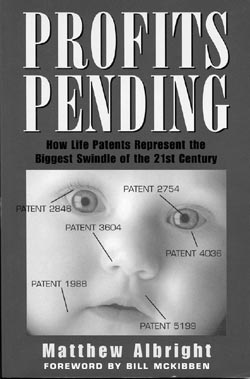|
 Profits
Pending: How Life Patents Represent the Biggest Swindle
of the 21st Century Profits
Pending: How Life Patents Represent the Biggest Swindle
of the 21st Century
By Matthew Albright
Common Courage Press
234 pages
In her six short years of life, Dolly the cloned sheep
might have raised hopes for people interested in either
shameless narcissism or stem cell treatments. But those
hopes are rapidly deflating as the consequences of biotechnology
are seeping into peoples’ consciences.
Many of those consequences are found in Profits Pending,
a book by local author Matthew Albright. The book is primarily
a scientific look at how gene patenting in the United
States devastates medical advancement more than it fosters
it. Subtitled How Life Patents Represent the Biggest Swindle
of the 21st Century, the book might seem to a naysayer
a whacked-out view based on conspiracy. Unfortunately,
the use of the word “swindle” lends itself
to such a conclusion. However, the book is based on anything
but conspiracy.
Instead, it draws on a variety of scientific data and
discussion from organizations fighting to ensure science
and politics don’t stifle inventions that could
save peoples’ lives. Essentially, Albright writes
about how the U.S. patent system allows corporations,
universities and research institutions to monopolize and
profit from things nature created. In other words, they
are taking human genes, human proteins and other molecules
found in the body and legally protecting them.
As an example, Albright briefly tells readers about the
Greenberg family. Two of the Greenberg children died from
a rare neurological disorder called Canavan disease. While
still only infants, medical researchers used them as a
starting point to begin researching the genetic causes
of the disease. The Greenberg parents and 160 other families
provided blood and tissue samples for the project. Ultimately,
a researcher at Miami Children’s Hospital identified
a mutation of a specific gene that was associated with
the disease. The information was later used to develop
a test to screen for the mutations. In the process, the
hospital successfully patented the gene. But the story
doesn’t result in a cure for the disease. In fact,
it doesn’t even result in significant gain in the
medical community.
By patenting the gene, the hospital restricted, even
altogether denied, other researchers from investigating
Canavan disease. Researchers who used the screening test
were legally bound to pay royalties to the hospital. In
effect, the Greenbergs and other families whose children
died from Canavans handed the hospital a pot of gold.
“What the hospital has done is a desecration of
the good that has come from our childrens’ short
lives,” the father of the Greenbergs told the Chicago
Tribune. “I can’t look at it any other way.”
Albright jumps off from this story to explain that patenting
genes in the name of medical advancement is just a bunch
of hooey, especially since reportedly 10 percent of illnesses
people suffer are caused by a combination of genes, environment
and lifestyle.
Albright writes: “Companies are now patenting diseases
themselves like tuberculosis and staph infection. Instead
of helping to prevent or cure these diseases, however,
the race for these patents engenders secrecy in research
and creates walls between scientists.”
On the surface, the argument for patents seems mostly
clear – that genes must be patentable in order for
firms to recoup their investment in identifying them.
But as Albright goes on to argue, this practice affects
society beyond medical advancement. These patents (known
as “life patents”) threaten the already slippery
slope of intellectual property. They create monopolies
and abuse political power. And because gene patent ownership
is so important to biotech companies’ stock market
valuation, they can cause market upheaval (remember in
2000, when former President Bill Clinton and British Prime
Minister Tony Blair sent biotech stocks plunging by suggesting
that raw human gene sequence data “should be made
freely available”?).
With the varying implications of how we treat genes (be
it for diseases or cloning), there is an astounding amount
of theory, evidence and opinion surrounding these patents.
In his book, Albright does, by and large, an impressive
job of explaining this issue in laymen’s terms.
Usually, he keeps the text to palatable ideas and phrases.
He also provides extensive notes so that readers can judge
for themselves how much of a “swindle” this
is (25 pages of notes in a book with chapter pages that
don’t quite number 200). The only things that bog
down the book are Albright’s subheads and random
quotes by talking heads. Still, these things are not enough
to damn the book to the resale bin.
However, this book does not necessarily have mass readership
appeal. It’s more likely to call out to academics
that enjoy a stimulating dialogue about a topic fit for
a doctoral dissertation. Still Albright works to ferret
out the legalese and extenuating arguments, and he delivers
a message on a complex topic that is more than just about
counterfeit sheep. It’s about how all of our genes
can be easily sold to the highest or swiftest bidder.
|

